York Region
Operations & Maintenance Bus Garage
The 230,000 ft2 Bus Garage in Vaughan, Ontario was retrofitted to accommodate the storage and maintenance of 230 York Region Transit (YRT) buses.
The facility was improved through a wide range of bus servicing equipment and building automation systems to minimize energy use and maximize operational efficiency. Both a new admin area and a training facility were included in the retrofit, which has been certified LEED® Silver.
The facility features state-of-the art ventilation and exhaust systems. There are two service lanes consisting of four indoor fuel pumps, vacuum stations, welding and body shop, paint booth, parts storage, tire bay, machine shop, two inspection pits, lubrication stations and two washers.
Our electrical scope included: normal and emergency power distribution design, fire alarm system design, telephone/data, communication conduit/raceway design, security system conduit/raceway design, system clock design, indoor lighting, and outdoor lighting design to meet LEED® Silver requirements.
SERVICES
Mechanical Engineering | Electrical Engineering
PROJECT FEATURES
Size: 230,000 ft2 | Status: Completed 2010
LOCATION
Vaughan, Ontario
KEY SCOPE ELEMENTS
Building automation and bus servicing equipment to improve operational efficiency | Normal and emergency power distribution | Energy-efficient system design to reduce water and energy demand | LEED Silver Certified

Energy efficient systems design
The building was designed to reduce energy and water demand. It includes a solar hot water system, and collection and storage of rainwater for washing buses and flushing toilets. The high efficiency HVAC system employs air-to-air heat exchange and is governed by a Building Automation System.
Best practices for environmental gains
Specifying for the light coloured roof helps reduce cooling demand in summer and mitigates the heat island effect. Interior materials and finishes were selected for the best possible indoor air quality. The construction waste diversion target was 95%. Best practices commissioning was used to ensure the building operates at optimal efficiency.

